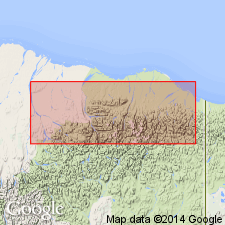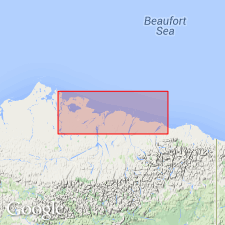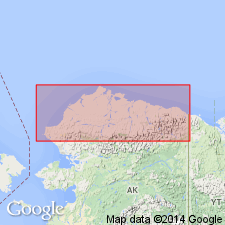
- Usage in publication:
-
- Franklin Bluffs Member*
- Modifications:
-
- Named
- Reference
- Dominant lithology:
-
- Clay
- Silt
- Sand
- Gravel
- Ash
- AAPG geologic province:
-
- Alaska Northern region
Summary:
Named as middle member (of 3) of Sagavanirktok Formation. Type section designated as exposures along stream cutting west side of Franklin Bluffs 1.8 km (1.1 mi) S 10 deg W of VABM Greta, 69 deg 49'N, 148 deg 39'W to 148 deg 41'W, northern AK. Reference locality designated at Carter Creek. Generally forms northernmost low hills on Arctic Coastal Plain. Is cyclic-bedded subaerial deposit of gray to brown clay and silt, massive units of pink, tan, orange, and yellow unconsolidated sand and gravel interlayered with beds of volcanic ash. Is at least 900 m (3000 ft) thick. Probably conformably overlies Sagwon Member (new) of Sagavanirktok Formation. Conformably underlies Nuwok Member (new) of Sagavanirktok Formation and in part unconformably underlies unconsolidated terrace gravel. Age is considered Oligocene(?) and Miocene(?) based on stratigraphic relations.
Source: GNU records (USGS DDS-6; Menlo GNULEX).

- Usage in publication:
-
- Franklin Bluffs Member*
- Modifications:
-
- Age modified
- Biostratigraphic dating
- AAPG geologic province:
-
- Alaska Northern region
Summary:
Age of unit is Eocene to Miocene(?) based on early to middle Eocene palynomorphs and dinoflagellates from type section; type section age given as early to middle Eocene.
Source: GNU records (USGS DDS-6; Menlo GNULEX).

- Usage in publication:
-
- Franklin Bluffs Member*
- Modifications:
-
- Revised
- Age modified
- Reference
- AAPG geologic province:
-
- Alaska Northern region
Summary:
Pg. 3-5 (figs. 2-4), 6-8 (table 1), 43-47. Franklin Bluffs Member of Sagavanirktok Formation. As revised, lower part consists of a basal conspicuous light-gray- to pink-weathering siltstone, sandstone, and conglomerate unit, 250 to 400 feet thick, capped by a white-weathering conglomerate, estimated to be 120 to 210 feet thick (may mark the begininning of a new sequence, its base may represent an intra-Eocene unconformity). Overlies brown-weathering, lignite-bearing silty mudstones of White Hills Member (new) of Sagavanirktok Formation; rocks previously included in lower part of Franklin Bluffs Member by Detterman and others (1975), and in upper part of Sagwon Member of Sagavanirktok Formation by Frederiksen and others, 1994 (USGS Open-File Rpt. OFR-94-653) and 2002 (Palynology, v. 26). Upper part of Franklin Bluffs not exposed and is known only from subsurface well control, thickness probably 3,000+ feet. Underlies Nuwok Member of Sagavanirktok Formation, nature of contact unknown. Fossils (palynomorphs). Lower part of member is probably early and middle(?) Eocene, based on palynomorphs identified from underlying coaly beds (here considered top of White Hills Member), citing Fredericksen and others, 1994 (USGS Open-File Rpt. OFR-94-653), 1996 (USGS Open-File Rpt. OFR-96-84), and 2002 (Palynology, v. 26). Upper part may be as young as Miocene in eastern Colville basin. Age of Franklin Bluffs is considered early Eocene to Miocene.
Source: Publication.
For more information, please contact Nancy Stamm, Geologic Names Committee Secretary.
Asterisk (*) indicates published by U.S. Geological Survey authors.
"No current usage" (†) implies that a name has been abandoned or has fallen into disuse. Former usage and, if known, replacement name given in parentheses ( ).
Slash (/) indicates name conflicts with nomenclatural guidelines (CSN, 1933; ACSN, 1961, 1970; NACSN, 1983, 2005, 2021). May be explained within brackets ([ ]).

